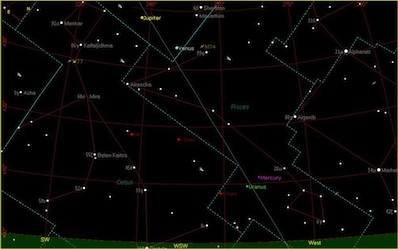


|

|
 |
|
Mercury in the evening MARK ARMSTRONG ASTRONOMY NOW Posted: 02 March 2012 Mercury is now at its best in the evening sky for us in the UK in 2012 and there’s never been a better time to track down the often-elusive innermost planet. Mercury reaches greatest elongation east from the Sun (18°) on 5 March but it will be visible in the western sky until around the middle of March and then be swallowed up by the twilight.  Open larger image. Early March sees a great opportunity to observe elusive Mercury shortly after sunset. The presence of Venus and Jupiter too makes for a great photo-opportunity. Graphic made using the Sky version 5. www.bisque.com As soon as the sky has darkened sufficiently and the Sun has definitely set then look for Mercury – on 5 March the Sun sets around 5.45pm and the end of civil twilight occurs at 6.20pm, so that’s a good time to spot it, although it will be visible slightly earlier than that with optical aid. Mercury will be a healthy ten degrees above the western horizon below the blazing pair of Venus and Jupiter. One way of estimating how far up in the sky Mercury will be is to hold your hand out westwards with your fingers spread. The average span between the tip of your little finger to your thumb is 18 degrees. Mercury will be quite bright, fading from magnitude -0.66 on 2 March to -0.26 on 5 March. Through a telescope its phase will decrease from 58 percent to 8 percent as its apparent diameter grows from 6.8 arcseconds to almost 10 arcseconds at the end of its visibility for this apparition. By mid month (15th) it will be much fainter at around mag. +2.5 and very difficult to spot, a mere four degrees up at the end of civil twilight. There’s very little in the way of surface marking that are readily visible on Mercury but if the seeing is good and you have a moderate aperture then you may be lucky. The whole scene in the western sky after dark in early March is very picturesque, with Jupiter and Venus prominent. If you have a clear western horizon or can travel to get one then why not try some simple snap shots with your digital SLR camera – Astronomy Now will be delighted to receive your images! Mercury passes through inferior conjunction on 20 March. |
|
|
|
|